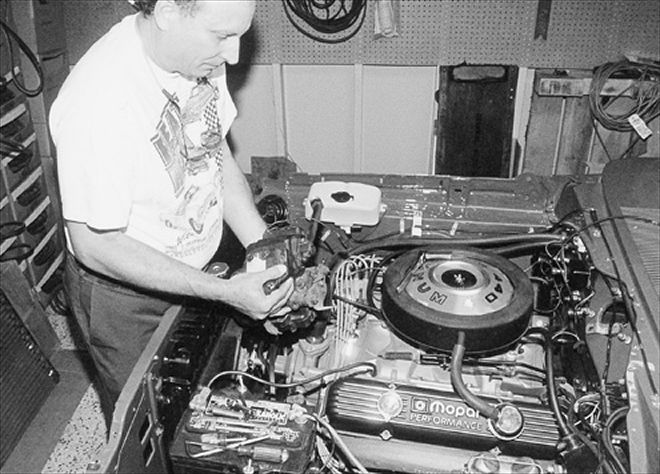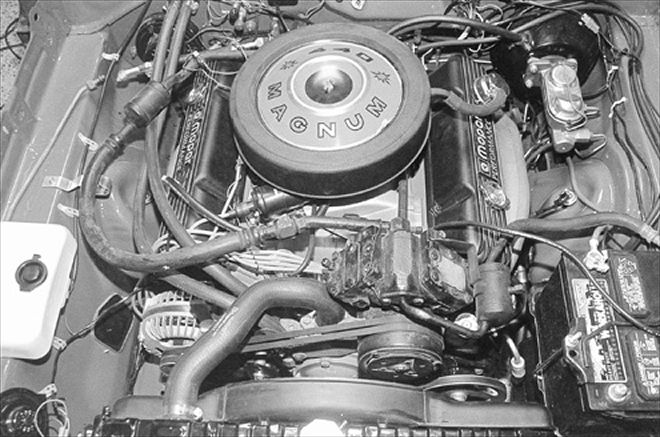

Think back to, oh, say August. Remember how hot that cruise was on Saturday? It doesn't matter which Saturday, because in August, they were all hot. Same with June and July. Yeah, there's nothing like peeling yourself off of your vinyl seat covers and actually being glad to get out of the car because you can go stand in the shade (instead of being trapped in that greenhouse we call a passenger compartment) and enjoy what's passing for a breeze. Plus the back of your shirt will dry out, which is always nice.
You know you've been there!
The Paddock Project Charger was originally equipped with air conditioning, which owner Mike Paremsky was adamant about keeping. However, he wasn't particularly thrilled with the factory system for one reason: the compressor.
First, the compressor is a dinosaur, and weighs nearly as much as one of the ancient reptiles. The factory RV-2 compressor is constructed of cast iron and weighs in at nearly 45 pounds. Because it was the original unit, the compressor would also have to be rebuilt to perform. Mike also wanted to convert the system over to R134a refrigerant for ease of maintenance, though as we've discussed in previous stories, this is easily accomplished during the rebuild process ("Ice Age Returns," Sept., Oct., Nov., 1999). Finally, its design isn't the most efficient, with one of the results being a parasitic loss on the engine of about 12-15 horsepower. Heavy and horsepower robbing--not things you generally want on a performance vehicle, particularly on the nose of the vehicle.
 The stock A/C compressor: It gets the job done, but the technology behind it is close to 40 years old. It's heavy, not the most efficient, and it's bulky and none-to-attractive in a modified engine bay.
The stock A/C compressor: It gets the job done, but the technology behind it is close to 40 years old. It's heavy, not the most efficient, and it's bulky and none-to-attractive in a modified engine bay.
We've worked with Classic Auto Air in Tampa, Florida, on other A/C system restorations and conversions, and as luck and timing would have it, they had just developed an A/C compressor retrofit kit that replaced the stock RV-2 compressor with a smaller, lighter and more efficient Sanden air compressor.
The crux of their conversion is a pair of brackets that allow the Sanden compressor to mount in the stock location, even using the factory-length fan belts for the compressor clutch and the original hard refrigerant lines. This is truly a remove-and-replace deal that will net you a more efficient compressor with a parasitic loss of about three horsepower, works at a much higher rpm than the stock unit, is close to thirty pounds lighter than the iron pump, and is more attractive in the engine compartment due to its smaller, less clumsy design and aluminum housing. For those with really detailed engine compartments, Classic Auto Air also stocks fully polished aluminum Sanden compressors.
Classic Auto Air also supplied us with brand new, correct reproduction A/C hard lines and restored our original plenum box. They checked and inspected all the other components of the system, replacing what was needed.
The system is supplied with the a new thermostat and expansion valve, so there are no other components to buy: just install the system and have it charged by a certified technician.
And if you'd rather retain the original compressor, you want to concours restore your entire system, or you want to add A/C to a car that didn't originally come so equipped, Classic Auto Air can supply you with everything you'll need to cool the cabin.
Not Cool Refrigerant
The automotive, automotive aftermarket, and refrigerant industry (not to mention the federal government) only recognize R12 and R134a refrigerant as being safe and acceptable for automotive use. DuraCool 12a, HC12a, OZ12, OZ12a, and other hydrocarbon refrigerants are extremely flammable and totally illegal to use in an automotive A/C system. These refrigerants are designed for use in commercial refrigeration systems, not transportation environments. Commercial or industrial systems are completely plumbed with hard steel lines, with no rubber hoses to cut through or leak flammable refrigerant into a passenger or engine compartment, are out in the open rather than an enclosed area, and are not susceptible to crashes or accidents (breakage and sparks).
Aside from the illegality of it, lubricants designed for use with R12 and R134a will chemically react with these other types of refrigerants, which will cause internal corrosion of your system, trashing your parts. The bottom line is this: R134a and R12 are the only legal refrigerants to use in your car. By using them, you won't suffer internal component failures, you won't contaminate the local shop's equipment when they service your system, it's not flammable, and it's the law.